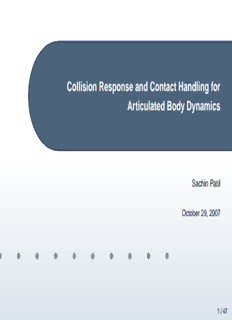
Collision Response and Contact Handling for Articulated Body PDF
Preview Collision Response and Contact Handling for Articulated Body
Collision Response and Contact Handling for Articulated Body Dynamics Sachin Patil October 29, 2007 1 / 47 Collision Response in Rigid Bodies CollisionResponseand (cid:4) Collision detection and generating appropriate collision responses is ContactHandlingfor RigidBodies an integral part of any rigid body simulator Overviewof Featherstone’sABM (cid:4) Contacts are primarily of two kinds: Impulse-basedcollision responseforABD Constraint-based (cid:3) Colliding contacts : vrel < −(cid:15) collisionresponsefor ABD (cid:4) Bodies “bounce” off each other, coefficient of restitution Collisionresponsefor governs bounciness AdaptiveABD (cid:4) Instantaneous change in velocity (cid:4) Requires restart of the solver (cid:3) Resting contacts : −(cid:15) < v < (cid:15) rel (cid:4) Gradual contact forces prevent interpenetration (cid:4) No instantaneous changes in velocity (cid:4) Examples include sliding, rolling, stacking etc. 2 / 47 Colliding contacts (Impacts) CollisionResponseand (cid:4) These occur when two rigid bodies interpenetrate in a given time ContactHandlingfor RigidBodies step of the simulation Overviewof Featherstone’sABM (cid:4) Two approaches to resolve this: Impulse-basedcollision responseforABD (cid:3) Force driven methods Constraint-based collisionresponsefor ABD (cid:4) Penalty (based on penetration distance) restoring force is Collisionresponsefor applied to the bodies AdaptiveABD (cid:4) Easier, but slow objects react in a ’slow’ fashion to collision (cid:3) Impulse driven methods (cid:4) Apply impulses to colliding objects at point of collision causing instantaneous change in velocities (cid:4) For frictionless bodies, direction is the same as the normal direction at point of contact 3 / 47 Continuous contacts CollisionResponseand (cid:4) Any continuous contact is a constraint ContactHandlingfor RigidBodies Overviewof (cid:4) Two approaches to resolve such contacts Featherstone’sABM Impulse-basedcollision (cid:3) Impulse based methods responseforABD Constraint-based (cid:4) Inherently local in nature collisionresponsefor ABD (cid:4) Faster and simpler Collisionresponsefor AdaptiveABD (cid:4) No explicit contact constraints (cid:4) Cannot guarantee stability after resolution (cid:3) Constraint based methods (cid:4) Inherently global in nature (cid:4) Much more stable than local, impulse based methods 4 / 47 Resting contact response CollisionResponseand ContactHandlingfor RigidBodies Overviewof Featherstone’sABM Impulse-basedcollision responseforABD Constraint-based collisionresponsefor ABD Collisionresponsefor AdaptiveABD Figure 1: Resting Contact (cid:4) Apply normal forces fi nˆi at each contact point cp cp (cid:4) Solve all contact forces simultaneously (since they influence each other) which yields a linear system (cid:4) All forces subject to three conditions (outlined in the next slide) 5 / 47 Resting contact response CollisionResponseand (cid:4) Interpenetration must be prevented : a ≥ 0 ContactHandlingfor cp RigidBodies Overviewof (cid:4) Forces can only be repulsive (to prevent further interpenetration) : Featherstone’sABM f ≥ 0 cp Impulse-basedcollision responseforABD (cid:4) Constraint-based Forces should equal zero when the bodies in contact start to collisionresponsefor T separate : a f = 0 ABD cp cp Collisionresponsefor AdaptiveABD (cid:4) Normal accelerations depend linearly on the normal forces : a = Af + b cp cp (cid:4) This is a Linear Complementarity Problem (LCP) (cid:3) This formulation can also be used with impulse based methods 6 / 47 Linear Complementarity Problem (LCP) CollisionResponseand (cid:4) Need to solve a quadratic program to solve for the forces f ContactHandlingfor cp RigidBodies Overviewof (cid:3) Generally solving a LCP is an NP-complete problem Featherstone’sABM Impulse-basedcollision responseforABD (cid:4) There are two kinds of methods to solve such problems: Constraint-based collisionresponsefor (cid:3) ABD Pivoting algorithms Collisionresponsefor AdaptiveABD (cid:4) Use a finite number of steps and require the recursive solution of systems of linear equations (cid:4) Do not provide useful intermediate result (cid:4) Theoretically faster than iterative methods (cid:3) Iterative methods (cid:4) Converge to the solution (cid:4) Can be interrupted in the middle to yield a valid result (cid:4) Gracefully deal with singular systems 7 / 47 Linear Complementarity Problem (LCP) CollisionResponseand (cid:4) More details on how to compute the A and b matrices and the LCP ContactHandlingfor RigidBodies formulation for resolving resting contacts available in: Overviewof Featherstone’sABM (cid:3) Analytical Methods for Dynamic Simulation of Non-penetrating Impulse-basedcollision responseforABD Rigid Bodies, D.Baraff, Computer Graphics Proceedings, 1989 Constraint-based collisionresponsefor ABD (cid:4) More details on how to solve LCP problems available in: Collisionresponsefor AdaptiveABD (cid:3) Dantzig’s algorithm : Fast contact force computation for non-penetrating rigid bodies, D.Baraff, Computer Graphics Proceedings, 1994 (cid:3) Lemke’s algorithm : Lemke’s algorithm, the hammer in your toolbox, C.Hecker, 2004, http://www.d6.com/users/checker/dynamics.htm (cid:4) Incorporate friction in previous formulation for realistic looking results 8 / 47 Overview of forward dynamics methods CollisionResponseand (cid:4) Previously we came across the following methods to compute ContactHandlingfor RigidBodies forward dynamics for an articulated body Overviewof Featherstone’sABM (cid:3) Composite Rigid Body algorithm Impulse-basedcollision responseforABD (cid:3) Lagrange Multipliers method Constraint-based collisionresponsefor O O (cid:3) Featherstone’s (n) Articulated Body Method and (lg(n)) ABD Collisionresponsefor Divide-and-Conquer method AdaptiveABD (cid:4) This lecture will use Featherstone’s ABM as the primary forward dynamics algorithm for illustrating concepts in collision response and contact handling 9 / 47 Forward dynamics methods CollisionResponseand (cid:4) Traditionally two kinds of approaches adopted towards solving this ContactHandlingfor RigidBodies problem: Overviewof Featherstone’sABM (cid:3) Maximal coordinates Impulse-basedcollision responseforABD (cid:4) For m links, there are 6m state variables where each link Constraint-based collisionresponsefor is a rigid object ABD Collisionresponsefor (cid:4) Constraints used to keep the links together AdaptiveABD (cid:4) Straightforward extension of simple rigid body dynamics (cid:3) Reduced (generalized) coordinates (cid:4) The number of state variables is the same as the number of joints in the articulation hierarchy (cid:4) In spite of an intuitive representation, the equations of motion turn out to be much more complicated 10 / 47
Description: